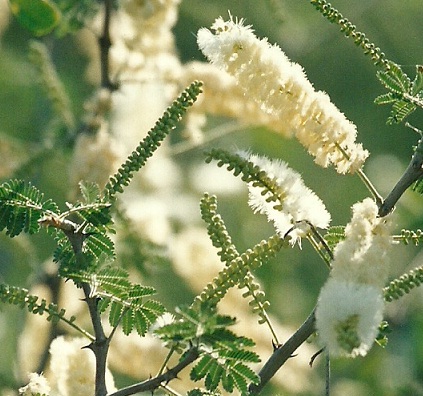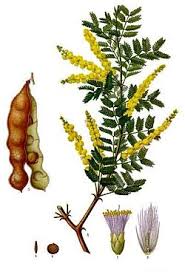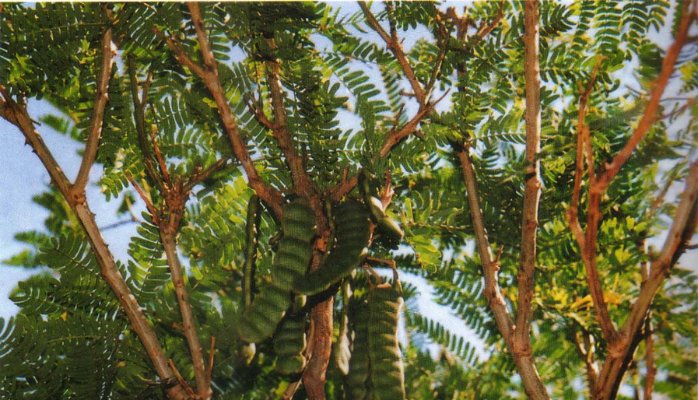Acacia senegal (L.) Willd.
| Botanical Name | Acacia senegal (L.) Willd. |
| Order: | Fabales |
| Family: | Mimosoidae |
| Genus: | Acacia |
| Species: | A. senegal |
| Common Names: | Gum Arabic tree (English); Gommier, Gommier Blanc; Acacia du Senegal (French) |
Plant Synonyms
Acacia verek Guill & perr; Mimosa senegal L.
Plant Local Names
Burkina Faso: Moore- gon- peelga, Dioula - patuku, Fulfulde-patukill, debehi, delbi.
Cote d’ivoire: Baule - kundo
Ghana: Sisaala - sofia, Hausa Akovia, Akoura
Mali: Bambara-patukil, Arabic-askab, Noms-patuki
Nigeria: Hausa-dakwara
Niger: Hausa-akkora
Senegal: wolof-Varekk, Serer- Ndongargavod
Plant Habitat
Acacia Senegal is found in the Africa sub-desert zone of Senegal to the Red Sea. In Senegal, it grows in light sahelaan soils and is commonly found in sandy coastlines of the islands of Saloum and Casamance in eastern Senegal and in the park of Ni0okolo-Koba (fortin et al., (2000).
Plant Material of Interest
Gum, Stem bark
Plant Description
Thorny shrub 6 to 7 m, with grey trunk, crcked, straight and sometimes with branches near the base; leaves oval shaped, bipinnate with 2-6 pairs of pinnae and 6-15 pairs of leaflets: inflorescence axillary; spikes with fragrant white flowers; pods are membranous plates of 11cm by 2 cm, with 7 or 8 seeds flattened and circular beige.
Plant Used Parts
Plant Uses
The moors and the Tuareg hardsmen harvest the plant for consumption. The latter use it to prepare a diet of milk, sugar, millet and dates (Fortin et al 2000) various preparation of the plants are prescribed for chest pain, migraine dysentery, diarrhoea, stomach-ache and colic; it is also used in veterinary medicine (Tabuti et al 2003, Kerharo and Adam. 1974). The gum exudate is used for the treatment of inflammation of the mucous membranes and externall as dressing for burns, nipple sores and leprous nodules (Parveen et al., 2007). The flower and gum decoction is used to treat conjunctivitis, dermatitis; bleeding and wounds (Jain et al., 2005) and leaves are believed to ward off evil spirits.
Plant Therapeutic Action
Expectorant, topical emollient, anti-inflammatory, mucous membrane protective, antihemorrhagic, vulnerary (Parveen et al., 2007: Jain et al., 2005; Fortin et al., 2000).
Plant Precaution for Use
As a pharmaceutical formulation excipient, gum Arabic, must be used in a correct proportions in cream, emulsions and suspensions.
Plant Adverse Effect
Allergic reactions to the gum and powdered forms of acacia have been reported and include respiratory problems and skin lesions administration may cause renal and liver damage (Leung and Foster, 1980).
Plant Contraindication
Its oral use in diarrhea must be medically supervised.
Plant Dosage Forms
Present as a formulation of infusions, suspensions, creams, emulsions and external or topical emollients
Plant Dosage
20 g per line of boiling water (Fortin et al., 2000)’
Plant Storage
Store in a cool dry place
Plant Chromatographic Fingerprint
Analytical TLC on silica gel G60 F254, 0.25mm layer in petroleum either (40-60 ?
Chloroform [2.8], detection in day light after spraying with antisaldehycle (0.5ml) mixed with 10 ml glacial acetic acid, 95ml methanol and 5ml concentrated sulphuric acid and heated to 100-110 ? For 5-10 min. presence of six characteristics spots with R,s 0.94 (yellow), 071 (pink), 0.48 (pink), 0.30 (purple), 0.25 (purple) and 0.22 (yellow).
Plant Constituents
Complex mixture of glycoproteins and polysacchariods (Arabic acid)
Magnesium and potassium salts; tannis (Karharo and Adam, 1974).
Test for identity and purity
Moisture content; 16.23%
Total ash: 9.46%
Water- soluble extractive: 53.40%
Plant References
Fortin, D., Lo, M., Maynart, G (2000). Plantes medicinales du sahel. Dakar, Enda-Editions, 2 Ed. 2000, 280p.
Gazi M.I (1991). The finding of antiplaque features in Acacia Arabica type of chewing gum Journal of clinical Periodontology 18: 75-77.
Haskell, W.L, spiller, G.A., Jensen, C.D., Ellis, B.K., Gates, fibre in the management of elevated plasma cholesterol in healthy subjects. American Journal of Cardoiology 69:433-439.
Jaine, a., Katewa, S.S., Galav. P.K., Sharma, p. (2005). Medicinal plant diversity of sitamata wildlife sanctuary, Rajasthan, India. Journal of ethno pharmacology 102:143-157.
Jensen, C.D., Spiller, G.A., gates, J.E Miller, A.F., Whittam, J.H. (1993). The effect of acacia gum and a water-soluble dietary fiber mixture on blood lipids in humans. Journal of American college of Nutrition 12:147-154.
Kerharo, J. Adam, G.J (1974). La pharmacopee senegalaise tradinonnelle, Plantes medicinales et toxiques VIGOT, PARIS, 1974, P. 241-245.
Leung A.Y., Foster, S. (1980). Encyclodppedia of Common Natural Ingredients Used in Food Drugs and Cosmetics. New York, NY: J. Wiley and Sons.
Marwah, R.G, Fatope, M.O., Al Mahrooqi, R, Varma, G.B et al. (2007). Antioxidant capacity of some edible and wound healing plants in Omen. Food chemistry 101:465-470.
Parveen, P., Upadhyay, B, Roy, S., Kumar, A (2007). Traditional uses of medicinal plants among the rural communities of Churu district in Thar Desert, India Journal of Ethno Pharmacology 113:387-399.
Tabuti, J.R.S., Lye, K.A, Dhellion, S.S (2003). Traditional herbal drug of Buluamogi, Ugenda: plants, use and administration Journal of Ethno pharmacology 88:19-44.


